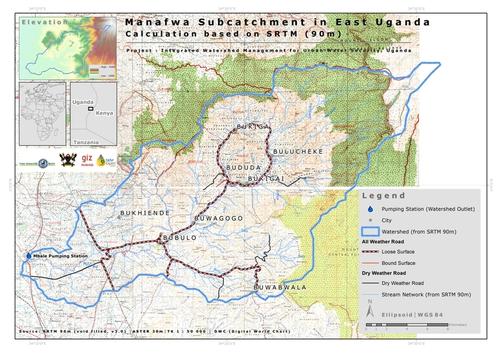Geographical introduction
The Manafwa subcatchment located in the Kyoga Water Management Zone (KWMZ) on the Ugandan side of Mt. Elgon. The outlet of the subcatchment are the Manafwa Waterworks. Two rain seasons occur whereas average annual precipitation totals around 1,500 mm; the mean monthly temperatures range between 15 °C and 27 °C. The forest of the Mt. Elgon National Park is the main ground water recharge source within the catchment.
The subcatchment is characterised by population growth, low income generating activities and weak infrastructural and service facilities. Ongoing deforestation due to a high firewood demand and land slides during wet season are the main risks. The decreasing Manafwa River base flow, which is essential for the fresh water supply of the subcatchment as well as the down stream located Mbale City, is one of the major concerns in the catchment.
Uganda is subdivided in four water management zones, which are not complete, based on hydrological boundaries, but are important zones for water management. The four zones are divided in subcatchment: the Manafwa subcatchment is one of them. The subcatchment is composed of the administrative entities Manjiya, Bubulo, and Bungokho County, including subcounties, parishes and villages.
The Manafwa subcatchment region, is located in the tropical Mt. Elgon climatic zone, which experiences a bi-model rainfall pattern. The average annual rainfall totals about 1,500 mm with rainy seasons occurring in the months of April till June and August till November. The mean annual maximum temperature is 27 ˚C and annual minimum temperature 15 ˚C.
The Mt. Elgon forest takes an important function of the ground and surface water resources of the Manafwa subcatchment. The infiltration rates vary from 1.2 cm/h to 363 cm/h depending on soil characteristics.
The Manafwa river is served by eight permanent tributaries. From it’s source to the outlet of the subcatchment at the Manafwa Waterworks, the river has a flow length of 43 km.
The geology in the Mt. Elgon region comprises of mainly Pre-Cambrian and Cainozoic rock formations including volcanices, granitites, and sediments. The rocks on the slopes are deeply weathered; the dominant soils are Vertisols, regionally known as “black cotton soils”. The top of the mountain are characterized by scarps of agglomerates in linear pattern. The relief is relatively undulating and hilly with the highest catchment elevation at 3,616 m a.s.l. and the lowest at 1,083 m a.s.l.
The catchment is highly influenced by past volcanic activities and the soil is very variable. The impermeable nature of most of the rocks makes the adjacent areas of Mt. Elgon vulnerable to landslides during wet seasons. Topsoils are shallow especially around the Mt. Elgon National Park. Generally, the soils in the highlands are clays, while those in the midlands and the lowlands are clay loams or sandy.
In the National Development Plan the written objective is water coverage of 100% in urban and 77% in rural areas by 2015. The desired objectives stagnate by around 67% in both cases.
The district (local) government is responsible for rural water supply but informal institutional structures dominate. One problem is the conflict of interests concerning environment and resource protection between social groups and community-based organizations.
The undulating land is widely cultivated by subsistence farming. Even wetlands and slopes are reclaimed for farmland resulting in soil erosion and river pollution. The land use is characterized by crop-, livestock -, and fish farming as well as agroforestry. There is also bee keeping, mushroom growing, quarrying and mining. Brick making is a recent activity with high economical value and cotton is the major cash crop. An increased firewood demand and Eucalyptus farming are the main reasons for deforestation.
The population of Mbale district as well as of the whole country is growing, estimated at 3.4% to 4.0% for Mbale City. Settlements develop alongside roads and close to water sources; they can be characterized as semi-permanent. Access to information about natural resource management is still low.
Currently, the environmental consequences of the lack of information and population growth are a serious land pressure leading to land degradation and water pollution.
